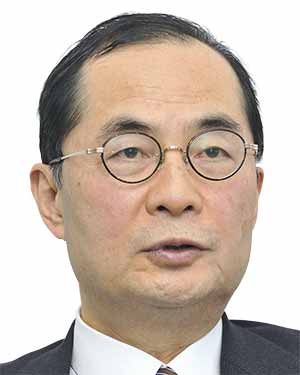18:04 JST, March 24, 2023
Haruhiko Kuroda will step down as the longest-serving governor of the Bank of Japan on April 8 after heading the central bank for 10 years. Under the leadership of economist Kazuo Ueda, who will succeed Kuroda as governor, the BOJ is set to face an array of challenges. Let’s start by looking at the current state of the Japanese economy.
Economic performance can be measured by two variables. One is gross domestic product — the sum of all the goods and services produced domestically in a given period. The real economic growth rate indicates how the GDP grows or contracts from one period to another, with the impact of changes in prices removed.
Economic affluence depends on real per capita GDP. In terms of the macroeconomic analysis metric of purchasing power parity, which takes price levels into account, Japan is now in 37th place in the world, far below Singapore and Taiwan. It has been overtaken by South Korea over the recent decade.
The other important variable is the level of prices. We are familiar with the prices of everyday goods and services. The consumer price index is compiled as a leading indicator of the overall change in consumer prices in each economy. The BOJ therefore keeps monetary policy targeted on the CPI.
Economic growth rates and prices are not unrelated to each other. However, their correlation is not simple, as there are a number of pathways through which they influence each other.
When the Great Depression hit the world in the 1930s, deflation occurred in the United States, with prices nearly halving over the course of a few years. As a result, one U.S. company after another collapsed and U.S. banks had to suspend lending activities as they were overwhelmed by nonperforming loans.
At that time, U.S. economic activity collapsed, exacerbating deflation further. It goes without saying that a vicious circle of violent deflation causing bad loans would inflict grave damage on the real economy.
The Japanese economy has already experienced a deflationary crisis of its own about 30 years ago — an across-the-board meltdown of stock and land prices that was triggered by the bursting of the asset price bubble. Those prices are known as asset prices and differ from prices of goods and services, which are usually referred to as consumer prices. In other words, Japan followed the same path that the United States did in the 1930s.
Since then, the Japanese economy has been suffering from an extended period of weak growth that is now known as Japan’s “lost three decades.” Over that period, non-regular workers have increased and income inequality has emerged as a major social issue.
In the early stage of the lost decades, a financial crisis developed in Japan as the delay in resolving the large stock of nonperforming loans caused a chain of failures among major financial institutions in 1997 and 1998. Around that time, Japan began witnessing a decrease in nominal wages, a development that was unprecedented in any developed country in the postwar period. At the same time, Japan’s consumer prices entered a lingering deflationary phase.
Nevertheless, the level of this consumer price deflation was totally different from the Great Depression and the asset price deflation in Japan that followed the abovementioned collapse of the bubble. In truth, it was too moderate to be blamed as the principal culprit for the country’s drawn-out economic stagnation.
For example, Japan’s consumer prices in fiscal 2012 — which ended in March 2013 or four days prior to the launch of the BOJ’s extraordinary monetary easing measures — declined a mere 0.2% from the preceding year. In hindsight, it can be said that prices were in an almost stable range at that time.
In the first half of the 19th century, the United Kingdom experienced slow deflation for decades, but its economy was in very good shape. The British Empire reached its heyday while it was undergoing a prolonged period of deflation. If U.K. history is an example, the link between deflation and economic stagnation is not clear.
Reflation policy failed
But economists and economic pundits who were regarded as “reflationists” shared the idea that deflation was the main cause of economic stagnation in Japan. They argued that prices are determined by the amount of money that is circulating in an economy and that more money should be injected into the economy to stop deflation. They said reflation policies were solutions provided by what they called the global standard of macroeconomics.
The extraordinary monetary easing framework that BOJ Gov. Kuroda introduced in April 2013 was obviously based on the thinking of reflationists. Pledging to “double the supply of money in two years,” the BOJ kept broadening the quantity of Japan’s monetary base at an unprecedentedly high pace.
The central bank neither printed large sums of money — Bank of Japan notes — nor distributed it to the public — that’s fiscal policy. What the BOJ did was continue open-market purchases of Japanese government bonds from financial institutions to increase the outstanding balances of their current accounts in the central bank. According to the BOJ’s scenario, those who saw such monetary operations would likely expect inflation to occur and the monetary easing would consequently cause prices to go up.
The outstanding balance of JGBs held by the BOJ stood at ¥94 trillion just before Kuroda took office as its governor. The comparable balance swelled to about ¥536 trillion as of the end of September 2022, accounting for nearly half the total of outstanding ordinary JGBs, which itself is equivalent to more than two times the GDP of Japan. Consequently, there was an almost sixfold rise in the country’s monetary base, but the BOJ failed to realize stable inflation of 2%.
In September 2016, the BOJ shifted the crux of its monetary policy from the quantity of money circulating in the economy to interest rates. Specifically, it introduced yield curve control (YCC), a new market operations framework in which the bank set a fluctuation range of long-term interest rates — 10-year JGB yields. This means that the BOJ broke with the tradition of controlling just short-term interest rates through open market operations for monetary policy implementation — it decided to directly control long-term interest rates as well.
The YCC framework contributed to keeping long-term interest rates at around zero. But it should be pointed out that interest rates have to be determined by markets. Interest rates play a role, similar to that of railway semaphore signals, to let investors know and select potential returns on distant future investments and ultimately give a go-ahead to really feasible ones. In contrast, the zero interest rate policy sends the default signal that “every investment is feasible.”
Though it is true that the Japanese economy itself offers insufficient opportunities for generating enough revenue, ultra-low interest rates are partly to blame for this reality. But zero interest rates would leave the lackluster economic environment intact, impairing the progress of the “economic metabolism.” This economic structure triggered an extreme drop in the Japanese yen’s foreign exchange rate last autumn under a globalized economic system.
The BOJ’s monetary policy centering on 10-year JGB interest rates has distorted the country’s interest rate structure. As the BOJ finally determined in December 2022 that this policy had reached the limit of its effectiveness, it raised the range of long-term interest rate fluctuations from 0.25% to 0.5%. Reacting to this policy modification, long-term interest rates immediately jumped to the upper limit of 0.5%, though leaving the interest rate structure distorted.
The extraordinary monetary easing remains in place despite Japan’s consumer prices having now increased by 3% to 4%, well above the BOJ’s target of 2%. Why? The central bank says it has not yet achieved “the price stability target in a sustainable and stable manner, accompanied by wage increases.” For its part, the government emphasized in a new package of economic measures, announced in October 2022, even taking center stage in spearheading this year’s annual spring wage hike campaign in the private sector, saying that the “most effective prescription” was to bring about “continual wage increases that keep pace with rising prices.”
Indeed, Japan desperately needs a macroeconomic environment that allows wage increases to outpace price markups. In the past 20 years or so, labor productivity levels in Japan have risen, yet wages have remained almost flat with the labor market experiencing even wage decreases in some sectors.
In other developed economies, wages have kept rising at a pace that monetary policymakers consider too fast. As a result, household consumption has increased, keeping those economies growing. Unlike them, Japan has been trapped in a situation without any increase in household income, keeping consumption — a yardstick for measuring economic affluence — stagnant. Wage increases are crucial to eliminate such economic stagnation. Make no mistake, the aim of wage increases is not to allow inflation to stabilize at 2%.
The BOJ has a host of challenges to tackle: the extraordinarily swollen balance sheet — which shows the outstanding levels of assets and liabilities — as well as financial market distortions and lax fiscal discipline resulting from the many years of ultra-low interest rates. The future of the world economy is uncertain — the United States has just witnessed the failure of two banks, as of this writing. Given these factors, it will not be easy for new BOJ Gov. Ueda, in his words, to “drive quietly and safely” once he assumes the post.
The essence of monetary policy lies in its agility. The current BOJ stance of sticking to the target of a sustainable, stable inflation rate of 2%, like the so-called one-legged flamingo batting stance, is inflexible — it is no longer productive.

Hiroshi Yoshikawa
Hiroshi Yoshikawa is a professor emeritus at the University of Tokyo. He has served as the chair of the Fiscal System Council, an advisory panel to the finance minister. He is the author of “Reconstruction of Macroeconomics: Methods of Statistical Physics, and Keynes’ Principle of Effective Demand.”
The original Japanese article appeared in the March 19 issue of The Yomiuri Shimbun.
"Editorial & Columns" POPULAR ARTICLE
-

Violations of Subcontract Law: Major Automakers Must Eliminate Old Practices
-

Local Governments’ Tax Revenues: Devise Ways to Correct Imbalances in Tax Sources
-

5 Japanese Business Dinner Mistakes to Avoid — and What They Taught Me About Business in Japan
-

Heavy Rains in Asia: Support for Victims, Flood-Control Measures Urgently Needed
-

Rice Coupons: A Misguided Approach to Countering Rising Prices
JN ACCESS RANKING
-

Keidanren Chairman Yoshinobu Tsutsui Visits Kashiwazaki-Kariwa Nuclear Power Plant; Inspects New Emergency Safety System
-

Imports of Rare Earths from China Facing Delays, May Be Caused by Deterioration of Japan-China Relations
-

University of Tokyo Professor Discusses Japanese Economic Security in Interview Ahead of Forum
-

Japan Pulls out of Vietnam Nuclear Project, Complicating Hanoi’s Power Plans
-

Govt Aims to Expand NISA Program Lineup, Abolish Age Restriction






















